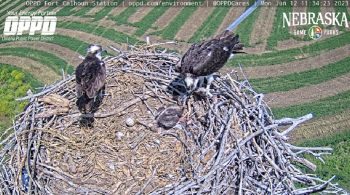Osprey chick hatches at Fort Calhoun Station

The ospreys at OPPD’s Fort Calhoun Station have welcomed a new chick into their nest.
The chick hatched May 28 from a group of three eggs laid. The female osprey has spent most of her time brooding – sitting on the chick and the unhatched eggs to keep them warm – but viewers can catch glimpses of the hatchling on the ospreys’ YouTube page.

The other two eggs are most likely not viable at this point and aren’t expected to hatch.
The ospreys’ home is the only known nesting site of its kind in eastern Nebraska. Their webcam was installed in time to let observers watch their stay in Nebraska in 2022. The camera made it possible for observers from around the world to watch the ospreys and their offspring.
Their nest sits atop a 50-foot power pole at the retired nuclear power plant. The ospreys moved there in 2021, after OPPD took down the 360-foot meteorological tower that held their previous nest in December 2020 as part of decommissioning efforts at the plant. The relocated nest sits about 300 feet from the original site.
Feeding and protecting their chick
The mother hasn’t left the nest very much, as is normal for ospreys that are protecting their young, said Chris Vrtiska, a wildlife natural resource specialist at OPPD. The father spends most of his time flying around and catching fish to feed the chick.
The hatchling is likely to start flying in less than two months, Vrtiska said. Ospreys can travel great distances; some that were born and banded in Massachusetts have been located as far away as Suriname, South America, he said. Many of the osprey in the Midwest migrate to Mexico and Central America. But once they’ve established a nest, they tend to stay there when the season is appropriate.
“They’re pretty loyal about coming to the same spot,” he said.

Grant Schulte joined OPPD as a content generalist in 2022. He is a former reporter for The Associated Press, where he covered the Nebraska Legislature, state politics and other news for a global audience. He is a graduate of the University of Iowa and a proud Hawkeye. In his free time he enjoys running, reading, spending time with his wife, and all things aviation.
View all posts by Grant Schulte >







